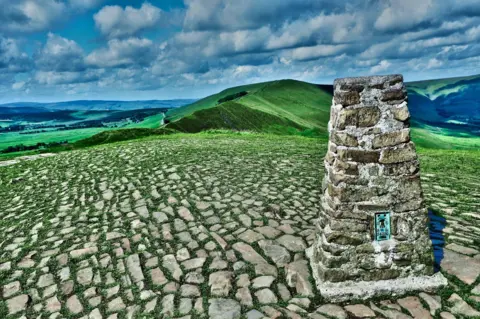The surge in popularity of Mam Tor, a prominent hill in the Peak District, has led to significant issues, including park congestion and environmental concerns. Known for its stunning views and relatively accessible trails, Mam Tor has become a favorite destination for hikers and outdoor enthusiasts, attracting almost a million visitors annually, according to data from the National Trust.
The idyllic site is especially enjoyed by local resident Ed Procter, who relishes the sight of hikers from his garden in Castleton. Procter shares that since moving to the area in 2012, he has witnessed a marked increase in foot traffic on Mam Tor. This rise is not without consequences; the trails are suffering from erosion, which has prompted repairs, including soil being airlifted to affected areas. This concern about the ecological impact of increased tourism is echoed across many communities that thrive on nature tourism, leading to a mixed sense of pride and frustration.
Market research indicates that hiking gained traction during the COVID-19 pandemic. However, Mam Tor has attracted a greater share of visitors compared to other walking spots within the Peak District. Procter is keen to see more people engage with the outdoors, yet he points out adverse effects such as troublesome littering and inappropriate parking, complicating local life. The volunteer-driven group, Concerned for Castleton, works with local authorities to address these issues, highlighting the disruptive nature of careless visitor behavior, including illegal parking that blocks roads, littering, and even incident reports of human waste.
This influx leaves residents in an uncomfortable position; while they appreciate the economic boost from tourism, many face inconveniences due to the behavior of visitors. Reports of blocked roads and emergencies caused by illegal parking are common, particularly as businesses struggle with disrupted waste collections and delivery access. Castleton Fish and Chips owner Rachel Holloway describes the struggle with delivery logistics, emphasizing that consistently improper parking leads to difficulties and increased waste collection costs.
Driving factors behind Mam Tor’s popularity include its proximity to major towns like Manchester and Sheffield, as well as its family-friendly facilities. Visitors are drawn by social media platforms like TikTok and Instagram, which promote the area as an appealing outdoor destination. The ease of access, especially the close-by car park allowing a brief 15-minute ascent, caters to casual walkers and Instagram influencers alike seeking picturesque sunrise views without the arduous hike typically associated with such experiences.
Craig Best, general manager for National Trust’s Peak District, acknowledges the unforeseen surge in visitors, resulting from pandemic-driven lifestyle changes and heightened social media presence. However, this phenomenon has heavy implications: increasingly, local authorities and conservation groups are pressured to devise strategies for managing the visitor influx and preserving the natural landscape. The National Trust is collaborating with various stakeholders, including the Peak District National Park Authority, Derbyshire County Council, and local law enforcement, to mitigate the adverse effects of tourism while enhancing visitor experiences.
Ultimately, while the tourism from Mam Tor contributes positively to Castleton’s economy, it calls for sustainable management to ensure the village remains enjoyable for both residents and visitors. Lawrence Key, a local business operator, articulates the delicate balance required in sustaining tourism while retaining community integrity. He suggests that there is an urgent need to expand parking facilities and improve public transport to accommodate the growing number of visitors without compromising the quality of life for local residents.
In conclusion, as Mam Tor continues to attract outdoor enthusiasts, the ensuing challenges highlight the crucial role of responsible tourism and community engagement to cultivate a supportive environment for both nature and the people who cherish it.



